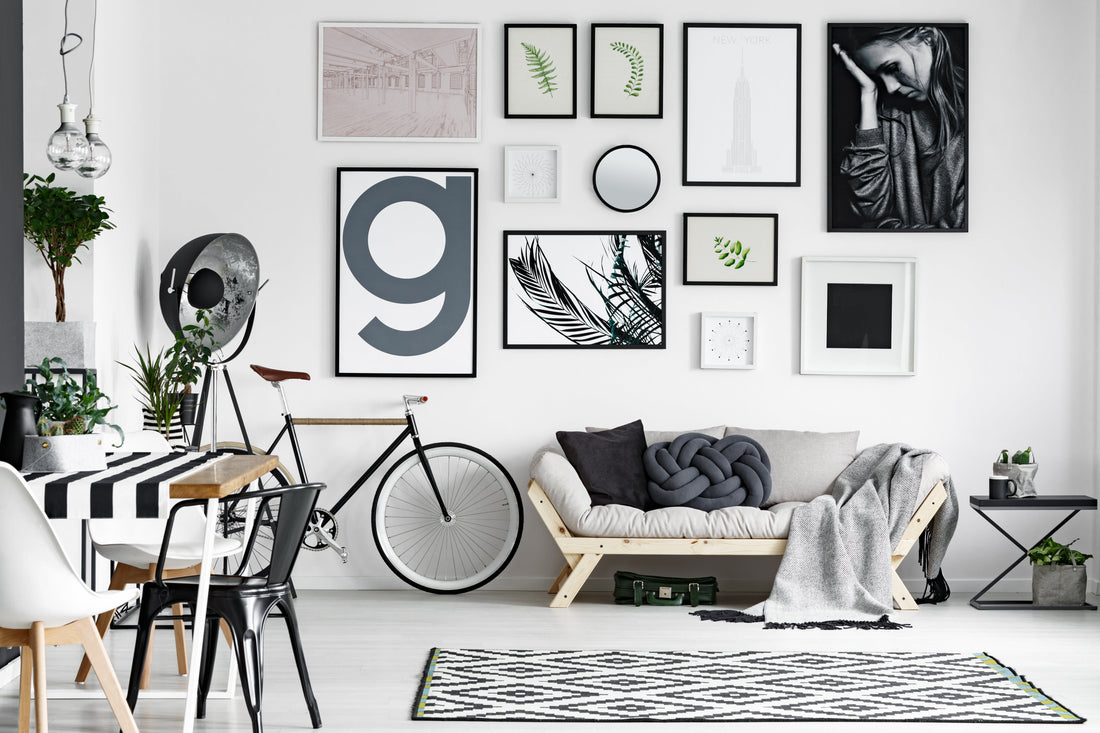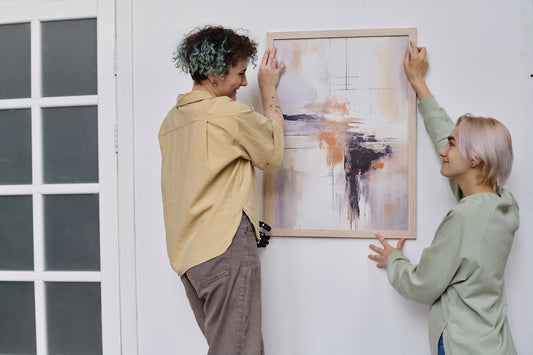
How to Space Pictures on a Wall When Mixing Sizes
Flaunt a gallery wall that’s chic and unique with all your favorite photos and artwork. Be bold to switch things up by learning how to space pictures on a wall from the largest piece to the smallest one. Each frame tells a story, and together, they collectively define a room. When mixing sizes, arrange frames at eye level. Hang the largest first, then arrange the smaller pieces around it. Art prints should be 2 to 3 inches apart to maintain visual balance.
In this blog, you’ll learn:
- Why Mixed Size Wall Art Works
- How to Choose the Right Art Sizes for Your Wall
- What Mistakes to Avoid When Spacing Mixed Size Pictures
Why Mixed Size Wall Art Works
For the love of art, there are no hard rules. Hanging art of different sizes gives your wall the makeover it deserves. Mixed size pictures add depth to the space without losing scale and proportion. In effect, your gallery wall becomes more dynamic and engaging. When curating your gallery wall, combining a variety of frame sizes can make it look better, all the while layering in more texture.
Here are the tools you’ll need to make an evenly spaced gallery wall layout.
- Measuring Tape
- Pencil
- Stud Finder
- Hanging hardware (nails and screws)
- Drill
- Hammer
- Screwdriver
Key Rules for Spacing Pictures of Different Sizes
When grouping frames, evenly space them together to create a cohesive display. Consider the largest picture as the focal point of your gallery wall. Then, spread smaller photos on each side so it doesn’t look crowded.
Rule of Thumb for Spacing
The general rule for art placement height is at least 57 to 60 inches from the floor. This way, your guests can comfortably view your art at eye level. The rule of thumb for spacing is 2/3 the size of your furniture near your gallery wall.
Balance Over Symmetry
The difference between symmetrical vs asymmetrical wall art relies on balance and visual interest. Frames with similar dimensions maintain a sense of harmony. Asymmetrical wall art shows uneven visual weight but still achieves a sense of balance through proper spacing. Consider the largest piece as an anchor while distributing pictures in different colors or textures for a varied look.
Consistency in Margins
Use the standard frame spacing rules when hanging pictures on a wall. Each artwork should be 2 to 3 inches apart. For larger walls, you can adjust the gap between the art prints to around 4 to 5 inches. In smaller rooms, bring the spacing down an inch.
Eye-Level Anchoring
A dynamic point of interest draws the eye to your mixed size wall decor. Your biggest piece will be your jumping point for your smaller pieces. Start placing the rest of your pictures around your largest artwork at eye level but off-center so the viewer’s focus travels around the gallery wall, rather than just looking at the centerpiece.
Layout Planning Tips Before Hanging
From the classic picture frame layout to a more modern take, get crafty with our gallery wall hanging tips.
Use Paper Templates
One way to hang your pictures is to create a DIY gallery wall template. It’s easier to visualize the spacing to see what your wall will look like. Before making paper templates, decide first if you want to hang them vertically or horizontally. Then, measure each paper template according to the size of each artwork. Test it first and tape them individually before making any holes in the wall.
Start from the Center and Work Outward
Pick your anchor piece and start working from there. Your largest artwork serves as your anchor piece. Work your way outward by filling in the spaces with the smaller pieces. Larger frames must be at the center, then continue with adding the rest next to the centerpiece.
Play With Color and Frames
Even spaces between frames are not enough to make your gallery wall look cohesive. Inject more variety by playing with colors. Your base color and frame finish should still depend on your focal piece. So if your largest frame is in white oak or light wood, this will be the main theme. You can also add frames with brass or metallic finishes to the mix.
Gallery Wall Templates You Can Follow
Want some inspiration? Check out these gallery wall templates.
Grid-like pattern
A grid-like pattern consists of a good mix of vertical or horizontal pieces. You can put three to five pieces together to create a grid-like pattern.

Medium gallery wall template
If you have more than three frames, this template works for you. Don’t be afraid to mix and match sizes for variety. Position the largest piece off-center, and arrange the smaller pieces around it.

Hierarchical wall template
Try placing horizontal and vertical frames next to one another. For example, two horizontal pieces will look best under a larger one. Moving the pieces around distributes attention to each artwork evenly.

Mistakes to Avoid When Spacing Mixed Size Pictures
Art terribly hung is distracting. Here are the common mistakes on hanging art and how to avoid them.
- Don’t display your pictures too high off the floor. Hang them just enough (57 to 60 inches) so your guests won’t have to crane their necks when looking at your gallery wall.
- Avoid putting your pictures too close together. If you fail to follow the standard wall art spacing guide, your gallery wall may look messy or crammed.
- Don’t stick to the same style and frame. It only makes your gallery wall look plain and dull. Instead, we recommend mixing and matching different colors and mediums for a more interesting visual overall.
Professional Designer Tips for Styling Mixed Media Prints
Here’s how to turn your gallery wall into a modern art arrangement as told by the experts.
Mix and match.
Curate a gallery that’s uniquely yours. Use different subjects and frames, says Christine Carney, director of design at Blackberry Farm Design. You can mix drawings, photographs, and artwork that you love.
Break away from traditional grids.
Add variety to your walls using the different templates we’ve shared above. According to CEO and interior designer Kari Bennett, experimenting beyond traditional layouts injects a sense of spontaneity into your pieces.
Embrace texture.
Customize your wall with layered frames and dimensional art, says Marie Cloud, principal designer at Indigo Pruitt. According to her, incorporating these elements makes your gallery more engaging.
Go big.
Interior designer Carissa Henderson of A Bold New Hue suggests choosing larger pieces for more depth and drama. This will make your room look and feel wider as you fill more space on your wall.
Find a common theme.
Whether that be a color, style, or frame type, pulling out a standard theme ties up a story for your collection, says Barbara Montgomery, the gallery director at The Vendue.
How to Choose the Right Art Sizes for Your Wall
The first step is to measure your wall using a tape measure. Follow the 2/3 rule, where the entire gallery occupies two-thirds of the available space. Afterward, choose a larger piece, the one that anchors your whole collection. Vary the sizes and orientation with both horizontal and vertical pieces. You can move pieces around until you find the perfect layout.
Showcase Example Layouts With Product Suggestions
Check out our sample layouts below.
Asymmetrical
Feel free to mix and match different styles, frames, and sizes. You can simply choose a centerpiece and move the other pictures around it.

Suggested centerpiece: Wildflower Soul
Floating Frames
Arrange your art prints in such a way that they look like they’re floating on the wall. Floating frames make your canvas paintings and photographs truly stand out.

Suggested centerpiece: Where Fire Meets Foam
Alternating Symmetrical
This gallery wall layout features two different frame sizes. You can simply alternate between horizontal and vertical pieces while keeping the space between each frame even and consistent.

Suggested centerpiece: Autumn Brushstrokes
Final Thoughts on How to Space Pictures on a Wall
Designing your first gallery wall with art pieces in different sizes can be overwhelming. But with the right spacing and layout, you have nothing to worry about. The largest piece becomes your focal point. From there, you can easily spread the whole collection around it.
Frequently Asked Questions
Learn more about styling gallery walls with our FAQs below.
How far apart should pictures of different sizes be on a wall?
The standard distance between pictures on your gallery wall is 2 to 3 inches. Make sure that the spacing is proportional to their size. That means, the bigger the artwork, the more space you’ll need to allot between them.
What’s the best height to hang mixed size artwork?
Hang your artwork at eye level or 57 to 60 inches from the floor. The art prints must not be too close or too far from the furniture to prevent them from overwhelming the space.
Should all my frames match in a gallery wall?
No. You can mix and match different frame styles for extra depth and variety. However, there should be a common element between each frame to maintain balance.
Can I mix canvas and metal prints in one layout?
Yes. Combining canvas and metal prints makes your gallery wall look more interesting. It’s a great way to create a dynamic and eclectic space that’s visually appealing.
How do I create balance with large and small pieces?
Distribute them evenly throughout your space without clustering them altogether. You can start with the largest piece at the center and surround it with smaller pieces.
Give Your Gallery Wall a Boost

A gallery wall filled with memories deserves a special spot in your room. With the perfect balance of styles and sizes, you can curate your own featuring your favorite photos and art prints. Browse through thousands of art styles from Hive Artes Collections.



